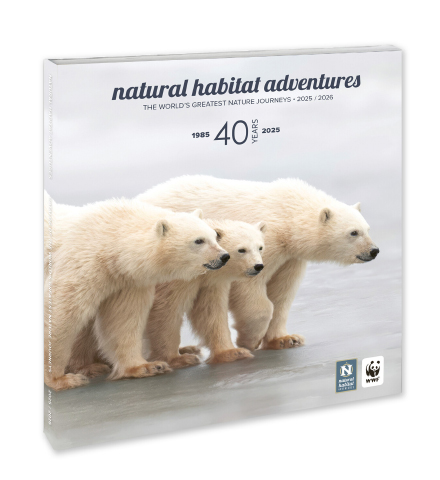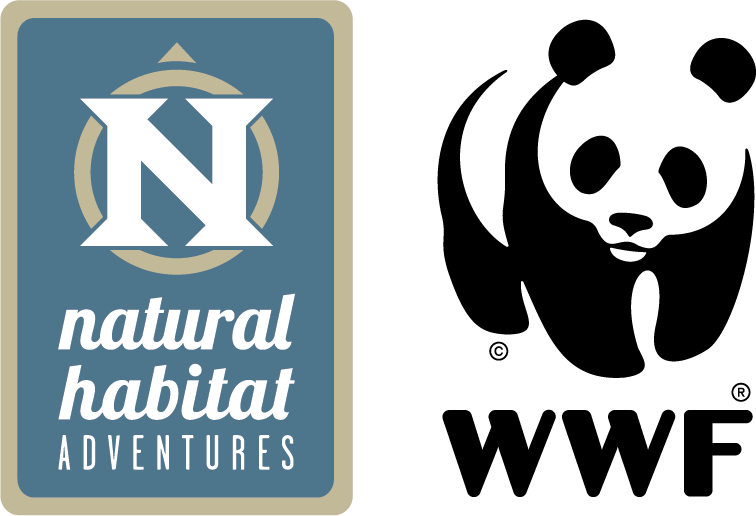It’s no secret: Nat Hab staffers are dog people. And cat people. Okay, we’re just…animal people. That’s why we’re thrilled when International Dog Day comes around each year on August 26. This is a day to celebrate all things canine, and with a mission of conservation through exploration, Nat Hab knows that the best way to appreciate (and protect) the world’s wildlife is through the awareness and understanding nature travel experiences provide.
In celebration of International Dog Day, here are Nat Hab’s top five adventures that offer a chance to see the world’s rare wild canines.
1. African Wild Dogs in Botswana

© Court Whelan
The African wild dog is one of the world’s most endangered mammals. Also called painted wolves for their distinct black, brown and white patchwork coloring, this canine species is seen most frequently in southern Africa. On Nat Hab’s flagship safari–our Secluded Botswana Safari–there’s a chance to see these dogs in their packs, along with zebras, elephants, giraffe, antelope, feline predators and much more. During this trip guests explore the Zambezi River, Victoria Falls, Chobe National Park, and the Okavango Delta, staying at luxurious tented camps throughout.
Spot African wild dogs on our Secluded Botswana Safari
2. Dholes in India

© Surya Ramachandran
The dhole is a canid—a member of the dog family—native to Central, South, East and Southeast Asia. The dhole, also known as the Indian wild dog or Asiatic wild dog, is also endangered. With fewer than 2,500 mature individuals remaining in the wild, they are no less threatened than the tiger and are on the IUCN red list.
On Nat Hab’s Grand India Wildlife Adventure—an in-depth nature odyssey in search of Bengal tigers and other rare wildlife, such as the one-horned rhino, sloth bears, barking deer and more—there is also a chance to spot the Indian dhole. They’re most commonly seen in open spaces such as riverbeds, jungle clearings and secluded spots where they prefer to take their rest. This nature odyssey explores three diverse national parks: Bandhavgarh National Park, Kanha National Park & Tiger Reserve, and Kaziranga National Park.
Search for dholes on our Grand India Wildlife Adventure
3. Gray Wolves in the United States

© Ray Doan
The domestic dog is a direct descendant of the gray wolf. The very best place on Earth to track and see gray wolves is in the remote Lamar Valley of Yellowstone National Park, and the ideal time of year is winter. Winter’s white mantle offers a pristine backdrop against which to search for these elusive icons of the wilderness. The landscape is fire and ice, where you can see steaming geysers and bubbling mud pots against a snowy backdrop, as you travel to Old Faithful in a private snowcoach. You also have the opportunity to take a horse-drawn sleigh across the National Elk Refuge for close-up views of vast winter herds of elk beneath the Teton spires.
See gray wolves on our Yellowstone Ultimate Wolf & Wildlife Safari
4. Arctic Foxes in Canada

© Dorothy Levine
That’s right: foxes are canines! Technically, they’re members of the genus vulpes, part of the sub-family Caninae, making them closely related to wolves and domestic dogs. During winter, the Arctic fox is pure white to blend into its snowy surroundings, and in summer, its fur changes to brown or gray to provide camouflage against the tundra. This wild canine can be spotted in both winter and summer on Nat Hab’s expeditions in Churchill.
See Arctic foxes on our Canada’s Premier Polar Bear Adventure and Belugas, Bears and Summer Wildlife of Churchill adventures
5. Maned Wolves in Brazil

The maned wolf is a large canine with long legs and a pronounced mane. They’re native to South America, and although they’re extremely rare, one the best places on the planet to spot these curious creatures is Brazil’s Pantanal, the world’s largest seasonal floodplain. Canine enthusiasts on Nat Hab’s Jaguars & Wildlife of Brazil’s Pantanal adventure may also be awarded the opportunity to see jaguars, as well as the other species the Pantanal abounds with, such as caiman, capybara, giant anteater, anaconda, macaws and more.
Look for maned wolves on our Jaguars & Wildlife of Brazil’s Pantanal tour


























